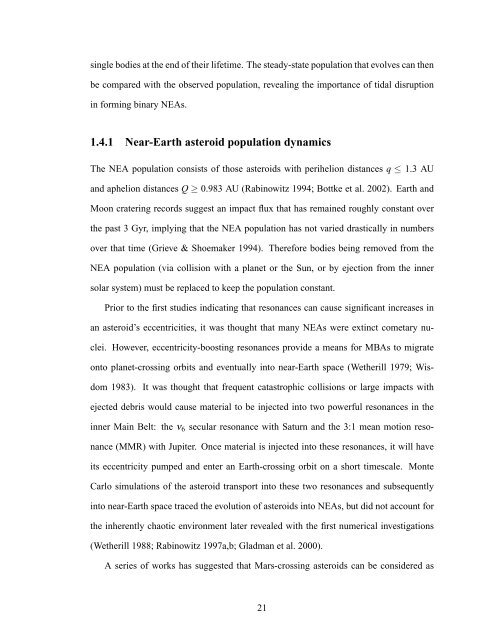Forming Binary Near-Earth Asteroids From Tidal Disruptions
Forming Binary Near-Earth Asteroids From Tidal Disruptions
Forming Binary Near-Earth Asteroids From Tidal Disruptions
Create successful ePaper yourself
Turn your PDF publications into a flip-book with our unique Google optimized e-Paper software.
single bodies at the end of their lifetime. The steady-state population that evolves can thenbe compared with the observed population, revealing the importance of tidal disruptionin forming binary NEAs.1.4.1 <strong>Near</strong>-<strong>Earth</strong> asteroid population dynamicsThe NEA population consists of those asteroids with perihelion distances q ≤ 1.3 AUand aphelion distances Q ≥ 0.983 AU (Rabinowitz 1994; Bottke et al. 2002). <strong>Earth</strong> andMoon cratering records suggest an impact flux that has remained roughly constant overthe past 3 Gyr, implying that the NEA population has not varied drastically in numbersover that time (Grieve & Shoemaker 1994). Therefore bodies being removed from theNEA population (via collision with a planet or the Sun, or by ejection from the innersolar system) must be replaced to keep the population constant.Prior to the first studies indicating that resonances can cause significant increases inan asteroid’s eccentricities, it was thought that many NEAs were extinct cometary nuclei.However, eccentricity-boosting resonances provide a means for MBAs to migrateonto planet-crossing orbits and eventually into near-<strong>Earth</strong> space (Wetherill 1979; Wisdom1983). It was thought that frequent catastrophic collisions or large impacts withejected debris would cause material to be injected into two powerful resonances in theinner Main Belt: the ν 6 secular resonance with Saturn and the 3:1 mean motion resonance(MMR) with Jupiter. Once material is injected into these resonances, it will haveits eccentricity pumped and enter an <strong>Earth</strong>-crossing orbit on a short timescale. MonteCarlo simulations of the asteroid transport into these two resonances and subsequentlyinto near-<strong>Earth</strong> space traced the evolution of asteroids into NEAs, but did not account forthe inherently chaotic environment later revealed with the first numerical investigations(Wetherill 1988; Rabinowitz 1997a,b; Gladman et al. 2000).A series of works has suggested that Mars-crossing asteroids can be considered as21












